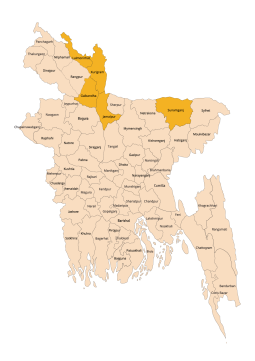
The USAID’s Strengthening Household Ability to Respond to Development Opportunities (SHOUHARDO) III-DRR Activity will foster locally led, sex-inclusive and policy-informed community resilience in the most vulnerable 22 unions in the flood-prone districts of Gaibandha, Jamalpur, Kurigram, Lalmonirhat and Sunamganj. SHOUHARDO III-DRR aims to reach more than 31,000 people over 24 months through flood resilient housing and community structures, climate smart agriculture, as well as building the capacity of community volunteers for advanced disaster preparedness. It will scale USAID’s SHOUHARDO III and Northern Bangladesh Disaster Preparedness (NOBADIP) plinth and preparedness activities and UNDP-NRP’s Piloting and Expansion Flood Preparedness Program (FPP) community flood preparedness, coping and response capacity enhancement, SuPER (Sustainable, Productive, Equitable and Resilient) Agriculture and expand geographic targeting beyond present CARE project areas. As a whole, SHOUIII-DRR will achieve its goal by reducing most vulnerable flood-prone char dwellers risks through scaling-up flood-resilient shelter improvements, adaptive agricultural practices, and flood preparedness initiatives.

District | Upazila | Union |
Gaibandha | Fulchhari | Fazlupur, Uria |
Gaibandha sadar | Ghagoa, Gidari | |
Jamalpur | Islampur | Chinaduli, Noarpara |
Dewanganj | Bahadurabad, Hatibanga | |
Kurigram | Kurigram sadar | Bhogdanga, Mogolbasa |
Ulipur | Bazra, Thetrai | |
Lalmonirhat | Lalmonirhat sadar | Khuniagachh, Rajpur |
Hatibandha | Dawabari, Patica para | |
Sunamganj | Dowarabazar | Pandargaon, Surma, Laxmipur |
Tahirpur | Uttar (North) Shreepur, Dakshin (South) Bordal, Tahirpur Sadar |
6,700 individuals reached through household and community plinth-raising.
1,152 community volunteers trained in preparedness, early warning and response.
1,200 individuals engaged in community-level contingency planning and simulations.
4,879 individuals receiving Agricultural input followed by training.

Anisa Begum is one of the direct participants of the designed CfW intervention. Every year, she suffered from inundation due to floodwater and was forced to relocate to the shelter where she and her family faced some unusual problems e.g., scarcity of safe drinking water, insufficient food, lack of essential medicines, etc. She couldn’t afford the costs of plinth raising her house because of her family’s limited as a blessing for her as well as the initiative helped to respond and adapt to the impacts of floods and build a more resilient future for her. She expressed her gratitude by saying, “This CfW initiative is a blessing that I received this support of plinth raising during my most vulnerable time.”
© Copyright 2026 CARE Bangladesh. Powered By Bangladesh Online